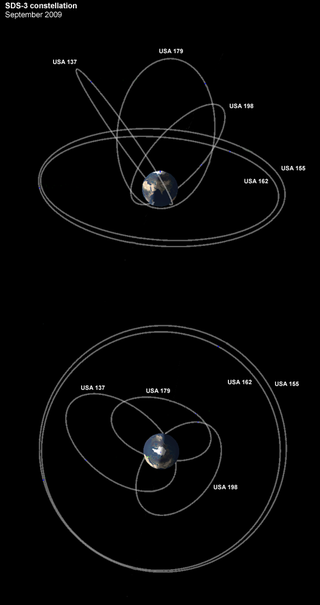Loading AI tools
American military satellite communication system From Wikipedia, the free encyclopedia
The Satellite Data System (SDS) is a system of United States military communications satellites. At least three generations have been used: SDS-1 from 1976 to 1987; SDS-2 from 1989 to 1996; SDS-3 from 1998 to the present. It is believed that these satellites were known by the code name Quasar.[1] The first generation was named simply 'SDS', the second generation was named 'Quasar' and the third generation each had their own designations.[2]

SDS satellites have a highly elliptical orbit, going from about 300 kilometers at perigee to roughly 39,000 km at apogee in order to allow communications with polar stations that cannot contact geosynchronous satellites. The high apogee meant that the polar regions were visible for long amounts of time, and only two satellites were required in order to achieve constant communications ability. In addition, two geostationary satellites appear to be part of the system. The SDS satellites were constructed by Hughes Aircraft Company.
The primary purpose of the SDS satellites is to relay imagery from low-flying reconnaissance satellites, notably the Keyhole optical reconnaissance and Lacrosse/Onyx radar reconnaissance satellites to ground stations in the United States.[3]


Each SDS-1 satellite had 12 channels available for Ultra high frequency (UHF) communication. They were cylindrical in shape, roughly 25 ft (7.6 m) long. 980 watts of electrical power were available from solar panels and batteries. The SDS-1 had a mass of 630 kg (1,390 lb) and was launched on Titan-3B rockets. The SDS-1 satellites had similar orbits to the Air Force's Jumpseat ELINT satellites.[4]
It has been speculated that the early satellites served as data relays for the first KH-11 Kennen reconnaissance satellites.[5]
The SDS-2 is significantly more massive at 2,335 kg (5,148 lb), with three separate communication dishes, including one for a K-band downlink. Two dishes are 4.5 m (15 ft) in diameter, while the third is 2 m (6 ft 7 in) in diameter. The solar arrays generate 1238 watts of power. It is believed that the Space Shuttle has been used to launch several satellites, possibly on missions STS-28, STS-38, and STS-53. Other launches have used the Titan IV launch vehicle.
| Name | COSPAR ID[6] SATCAT № |
Launch date | Launch vehicle | Launch site | Launch designation | Perigee | Apogee | Inclination | Remarks |
|---|---|---|---|---|---|---|---|---|---|
First generation | |||||||||
| OPS 7837 | 1976-050A 08871 |
2 June 1976 | Titan III(34)B | VAFB, SLC-4W | SDS F-1 | 380 km | 39315 km | 63.3 deg | |
| OPS 7940 | 1976-080A 09270 |
6 August 1976 | Titan III(34)B | VAFB, SLC-4W | SDS F-2 | 380 km | 39315 km | 63.3 deg | |
| OPS 7310 | 1978-075A 10993 |
5 August 1978 | Titan III(34)B | VAFB, SLC-4W | SDS F-3 | 380 km | 39315 km | 63.3 deg | |
| OPS 5805 | 1980-100A 12093 |
13 December 1980 | Titan III(34)B | VAFB, SLC-4W | |||||
| USA-4 | 1984-091A 15226 |
28 August 1984 | Titan III(34)B | VAFB, SLC-4W | SDS F-5A | ||||
| USA-9 | 195-014A 15546 |
8 February 1985 | Titan III(34)B | VAFB, SLC-4W | USA-9 | ||||
| USA-21 | 1987-015A 17506 |
15 February 1987 | Titan III(34)B | VAFB, SLC-4W | SDS F-6 | ||||
Second generation | |||||||||
| USA-40 | 1989-061B 20167 |
2 June 1989 | Space Shuttle Columbia STS-28/Orbus-21S |
KSC, LC-39B | N/A | ||||
| USA-67 | 1990-097B 20963 |
15 November 1990 | Space Shuttle Atlantis STS-38/Orbus-21S |
KSC, LC-39A | Geosynchronous satellite, deployed along with Prowler and initially misidentified as a Magnum SIGINT spacecraft | ||||
| USA-89 | 1992-086B 22518 |
2 December 1992 | Space Shuttle Discovery STS-53/Orbus-21S |
KSC, LC-39A | |||||
| USA-125 | 1996-038A 23945 |
3 July 1996 | Titan IV(405)A | CCAFS, LC-40 | |||||
Third generation | |||||||||
| USA-137 | 1998-005A 25148 |
29 January 1998 | Atlas IIA | CCAFS, SLC-36A | NROL-5 | Capricorn, Molniya orbit | |||
| USA-155 | 2000-080A 26635 |
6 December 2000 | Atlas IIAS | CCAFS, SLC-36A | NROL-10 | Great Bear, geosynchronous satellite at 10° West | |||
| USA-162 | 2001-046A 26948 |
11 October 2001 | Atlas IIAS | CCAFS, SLC-36B | NROL-12 | Aquilla, geosynchronous satellite at 144° West | |||
| USA-179 | 2004-034A 28384 |
31 August 2004 | Atlas IIAS | CCAFS, SLC-36A | NROL-1 | Nemesis, Molniya orbit, final Atlas II launch | |||
| USA-198 | 2007-060A 32378 |
10 December 2007 | Atlas V 401 | CCAFS, SLC-41 | NROL-24 | Scorpius, Molniya orbit | |||
| USA-227 | 2011-011A 37377 |
11 March 2011 | Delta IV-M+(4,2) | CCAFS, SLC-37B | NROL-27 | Gryphon, geosynchronous satellite at 10° West, replaced USA-155 | |||
| USA-236 | 2012-033A 38466 |
20 June 2012 | Atlas V 401 | CCAFS, SLC-41 | NROL-38 | Drake, geosynchronous satellite at 144° West, replacement for USA-162 | |||
| USA-252 | 2014-027A 39751 |
22 May 2014 | Atlas V 401 | CCAFS, SLC-41 | NROL-33 | Geosynchronous satellite | |||
| USA-269 | 2016-047A 41724 |
28 July 2016 | Atlas V 421 | CCAFS SLC-41 | NROL-61 | Spike, Geosynchronous orbit, might be a new generation [7] | |||
| USA-279 | 2017-066A 42973 |
15 October 2017 | Atlas V 421 | CCAFS, SLC-41 | NROL-52 | Likely Geosynchronous orbit[8] | |||
Seamless Wikipedia browsing. On steroids.
Every time you click a link to Wikipedia, Wiktionary or Wikiquote in your browser's search results, it will show the modern Wikiwand interface.
Wikiwand extension is a five stars, simple, with minimum permission required to keep your browsing private, safe and transparent.